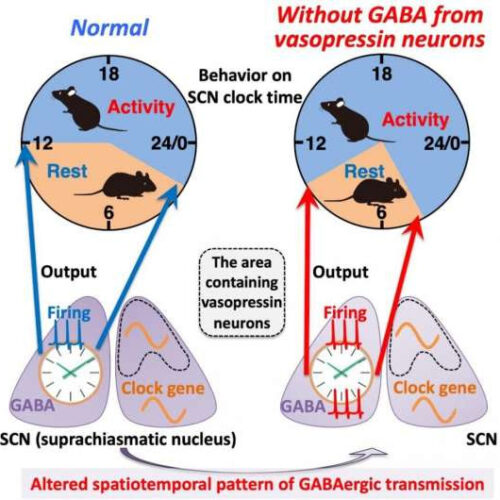by Ecole Polytechnique Federale de Lausanne Neuronal cell line (mHypoE-N41) transfected with NPY-mCherry (in red) and stained with phalloidin to label the actin cytoskeleton (in green). In this cell TGR5 was activated by its selective agonist INT-777 and this activation caused the stabilization and polymerization of the actin fibers (green) and the consequent accumulation of NPY...
Tag: <span>brain</span>
Anesthesia doesn’t simply turn off the brain — it changes its rhythms
Simultaneous measurement of neural rhythms and spikes across five brain areas reveals how propofol induces unconsciousness. In a uniquely deep and detailed look at how the commonly used anesthetic propofol causes unconsciousness, a collaboration of labs at the Picower Institute for Learning and Memory at MIT shows that as the drug takes hold in the...
Tweet and re-tweet: Songbird stuttering allows researchers to pinpoint causes in the brain
by Tufts University Credit: CC0 Public Domain Speech problems such as stammering or stuttering plague millions of people worldwide, including 3 million Americans. President Biden himself struggled with stuttering as a child and has largely overcome it with speech therapy. The cause of stuttering has long been a mystery, but researchers at Tufts University are beginning to unlock...
How proteins control information processing in the brain
by Martin-Luther-Universität Halle-Wittenberg Credit: Pixabay/CC0 Public Domain A complicated interaction between proteins is needed for information to pass from one nerve cell to the next. Researchers at the Martin Luther University Halle-Wittenberg (MLU) have now managed to study this process in the synaptic vesicles, which play an important role in this process. The study appeared...
How behavioral rhythms are fine-tuned in the brain
by Kanazawa University A schema summarizing the effects caused by the deficiency of GABAergic transmission from vasopressin neurons on circadian rhythms at multiple levels. Without GABA release from vasopressin neurons, the spatiotemporal pattern of GABAergic transmission alters within the SCN. Such an alteration does not significantly disturb the spatiotemporal organization of molecular clocks measured with clock...
Knowing how the brain retrieves facts may help people with memory disorders
by University of York Differential brain activity patterns in the retrieval of long-term memory types. Credit: Nature Communications (2021). A shared set of systems in the brain may play an important role in controlling the retrieval of facts and personal memories utilized in everyday life, new research shows. Scientists from the University of York say their findings may...
Botox sheds light on ‘inner workings’ of the brain, may unlock treatments for Parkinson’s disease
by Study FindsShare NEW YORK — Botox is best-known for its “fountain of youth” effects on an aging face, but scientists have uncovered a new use for the toxin. Researchers at New York University say Botox helps to reveal the inner workings of the brain — which could lead to treatments for Parkinson’s disease. The botulinum toxin shows...
HOW YOUR BRAIN FIGURES OUT WHAT SENTENCES MEAN
“It has been unclear whether the integration of this meaning is represented in a particular site in the brain, such as the anterior temporal lobes, or reflects a more network level operation that engages multiple brain regions,” says Andrew Anderson, research assistant professor in the University of Rochester Del Monte Institute for Neuroscience and lead author of...
Scientists from Russia and Germany measured how the brain learn new words
URAL FEDERAL UNIVERSITY IMAGE: YURI PAVLOV AND GERMANY COLLEAGUES ARE STUDYING THE BRAIN SIGNALS OF PEOPLE IN A VEGETATIVE STATE. CREDIT: URFU / NADEZHDA PAVLOVA. Researchers from University of Tübingen (Tübingen, Germany) and Ural Federal University (Ekaterinburg, Russia) have developed and experimentally tested new method to understand how the brain builds associations between previously unrelated words....
Research reveals how the brain inhibits remyelination in MS and how to treat it
by Ellen Goldbaum, University at Buffalo The inflamed tissue environment following demyelination prevents recruitment of oligodendrocyte progenitor cells (OPC) (green) and halts their division (red). This can be overcome by treatment with PI-88, a modulator of the heparanome (Credit: Darpan Saraswat Two papers by University at Buffalo researchers reveal important new findings as to how regeneration of myelin...









